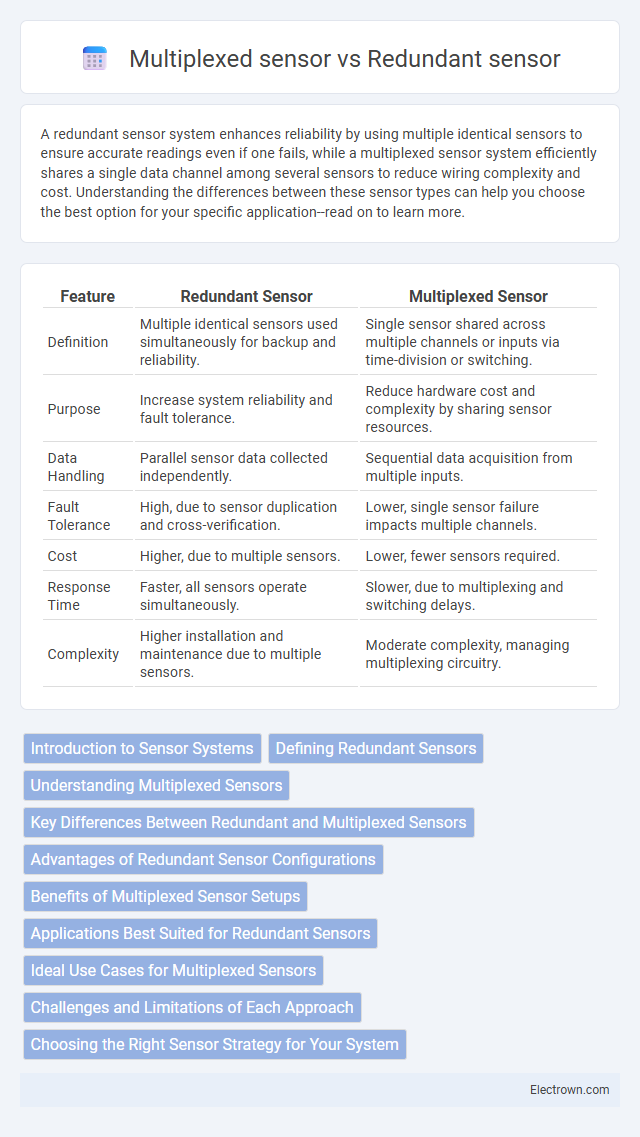A redundant sensor system enhances reliability by using multiple identical sensors to ensure accurate readings even if one fails, while a multiplexed sensor system efficiently shares a single data channel among several sensors to reduce wiring complexity and cost. Understanding the differences between these sensor types can help you choose the best option for your specific application--read on to learn more.
Table of Comparison
| Feature | Redundant Sensor | Multiplexed Sensor |
|---|---|---|
| Definition | Multiple identical sensors used simultaneously for backup and reliability. | Single sensor shared across multiple channels or inputs via time-division or switching. |
| Purpose | Increase system reliability and fault tolerance. | Reduce hardware cost and complexity by sharing sensor resources. |
| Data Handling | Parallel sensor data collected independently. | Sequential data acquisition from multiple inputs. |
| Fault Tolerance | High, due to sensor duplication and cross-verification. | Lower, single sensor failure impacts multiple channels. |
| Cost | Higher, due to multiple sensors. | Lower, fewer sensors required. |
| Response Time | Faster, all sensors operate simultaneously. | Slower, due to multiplexing and switching delays. |
| Complexity | Higher installation and maintenance due to multiple sensors. | Moderate complexity, managing multiplexing circuitry. |
Introduction to Sensor Systems
Redundant sensor systems use multiple identical sensors measuring the same parameter to enhance reliability and fault tolerance in critical applications. Multiplexed sensor systems share a single processing unit to sequentially collect data from multiple sensors, optimizing resource efficiency and reducing hardware complexity. Both approaches improve sensor system performance but differ in fault detection, cost, and system design considerations.
Defining Redundant Sensors
Redundant sensors are multiple identical sensors deployed to measure the same parameter, ensuring reliability and fault tolerance by providing backup in case one sensor fails. These sensors operate simultaneously or alternately to validate data accuracy and maintain system stability. Unlike multiplexed sensors, which share a single measurement channel sequentially, redundant sensors enhance safety in critical systems through parallel data acquisition.
Understanding Multiplexed Sensors
Multiplexed sensors integrate multiple sensing elements into a single system, allowing your device to monitor various environmental parameters efficiently through sequential or parallel data acquisition. These sensors reduce wiring complexity and cost by sharing common communication lines or interfaces, improving signal processing and power consumption. Understanding multiplexed sensors is crucial for optimizing your system's performance when managing diverse measurements compared to redundant sensors, which emphasize reliability through duplication.
Key Differences Between Redundant and Multiplexed Sensors
Redundant sensors provide multiple independent measurements of the same parameter to ensure reliability and fault tolerance, while multiplexed sensors share a single data acquisition system to measure multiple parameters sequentially, optimizing resource use. Redundancy is critical in safety-critical applications where sensor failure must not affect system operation, whereas multiplexing prioritizes cost and complexity reduction by minimizing wiring and hardware. Your choice depends on whether system reliability or resource efficiency is the primary concern.
Advantages of Redundant Sensor Configurations
Redundant sensor configurations provide enhanced reliability and fault tolerance by using multiple sensors to monitor the same parameter, ensuring continuous operation if one sensor fails. This setup improves data accuracy and system safety in critical applications such as aerospace, automotive, and industrial automation. Your system benefits from reduced downtime and increased confidence in sensor readings, which is essential for mission-critical environments.
Benefits of Multiplexed Sensor Setups
Multiplexed sensor setups offer significant benefits, including reduced wiring complexity and lower installation costs compared to redundant sensor configurations. By allowing multiple sensors to share communication channels or signal paths, these systems optimize data collection efficiency while maintaining reliable performance. Your deployment can achieve enhanced scalability and easier maintenance through streamlined sensor management in multiplexed arrangements.
Applications Best Suited for Redundant Sensors
Redundant sensors are best suited for critical applications requiring high reliability and fault tolerance, such as aerospace systems, nuclear power plants, and medical devices, where sensor failure can lead to catastrophic outcomes. These sensors provide continuous backup by simultaneously monitoring the same parameter, enabling immediate detection and correction of discrepancies to maintain system safety and performance. Your system benefits from redundant sensors when uninterrupted, error-free data acquisition is essential for operational integrity and safety compliance.
Ideal Use Cases for Multiplexed Sensors
Multiplexed sensors are ideal for applications requiring efficient monitoring of multiple parameters with limited wiring and space constraints, such as in smart buildings or automotive systems. They enable cost-effective data acquisition by sharing a single signal path among several sensor elements, reducing complexity and improving system integration. Your choice of multiplexed sensors optimizes performance when balancing sensor count with minimized wiring and enhanced data management.
Challenges and Limitations of Each Approach
Redundant sensors face challenges such as increased system complexity, higher costs, and difficulty in managing sensor calibration and synchronization. Multiplexed sensors often encounter limitations related to reduced data acquisition rates, signal interference, and decreased measurement accuracy due to sequential sampling. Both approaches require careful consideration of trade-offs between reliability, response time, and overall system performance.
Choosing the Right Sensor Strategy for Your System
Choosing the right sensor strategy depends on system reliability and complexity requirements. Redundant sensors provide backup measurements, enhancing fault tolerance by duplicating critical sensor functions, while multiplexed sensors share a single sensing element among multiple channels, reducing cost and wiring complexity. Evaluate the trade-offs between improved reliability in redundant setups and the efficiency and scalability offered by multiplexed configurations to optimize system performance.
Redundant sensor vs Multiplexed sensor Infographic

 electrown.com
electrown.com